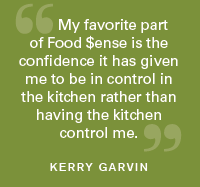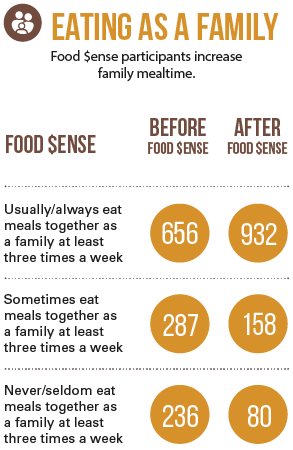Quick Guide to Extension Impacts: Food $ense
A Note From Utah's Food $ense Director
Dear Friends, The Utah State University Food $ense program, known nationally as the Supplemental Nutrition Assistance Program Educator (SNAP-Ed) assists thousands of Utah families each year in making healthy food choices on a limited budget. Group classes for adults and youth are the core of the Food $ense program. These classes address the specific needs of our participants and provide nutrition education as outlined in the current USDA Dietary Guidelines and MyPlate.
The Utah State University Food $ense program, known nationally as the Supplemental Nutrition Assistance Program Educator (SNAP-Ed) assists thousands of Utah families each year in making healthy food choices on a limited budget. Group classes for adults and youth are the core of the Food $ense program. These classes address the specific needs of our participants and provide nutrition education as outlined in the current USDA Dietary Guidelines and MyPlate.
- Heidi LeBlanc
What is Food $ense?
Food $ense serves individuals who are either food insecure or at risk of food insecurity. In 2013, the Food $ense program directly educated more than 11,295 adults and 26,115 youth in Utah and was present in all 29 counties across the state.
Although Food $ense reached a large number of people, there is still much work to be done. Food $ense continues its effort to grow and expand its education to low-income families in Utah, and partners with Department of Workforce Services, Women Infants and Children, Utah Department of Health, Utahns Against Hunger, Utah public schools and other state and local agencies. Through these collaborative efforts, Food $ense can help provide low-income families with nutrition resources that will help them make healthier choices for themselves and their families.


Creates Curriculum Assists With Nutrition Education
 In the fall of 2013, Food$ense unveiled the Creates Curriculum as a nutrition education curriculum for adults in Utah. Since then, several SNAP-Ed programs across the nation have adopted this curriculum. SNAP-Ed in Utah is currently evaluating the effectiveness of this curriculum regarding changed nutrition-related behaviors among low-income participants. The Creates Curriculum focuses on giving participants the courage and confidence to get in the kitchen and produce a meal, no matter where they are in the process of learning to cook. As they participate in this series, they will learn the basics of how to assemble a healthy meal that is quick, inexpensive and tasty. The curriculum also offers tips on how to have a carefully stocked pantry and kitchen with options and recipes for using what is available to create casseroles, stir fry meals, quick breads, soups, salads, sandwiches, desserts and more.
In the fall of 2013, Food$ense unveiled the Creates Curriculum as a nutrition education curriculum for adults in Utah. Since then, several SNAP-Ed programs across the nation have adopted this curriculum. SNAP-Ed in Utah is currently evaluating the effectiveness of this curriculum regarding changed nutrition-related behaviors among low-income participants. The Creates Curriculum focuses on giving participants the courage and confidence to get in the kitchen and produce a meal, no matter where they are in the process of learning to cook. As they participate in this series, they will learn the basics of how to assemble a healthy meal that is quick, inexpensive and tasty. The curriculum also offers tips on how to have a carefully stocked pantry and kitchen with options and recipes for using what is available to create casseroles, stir fry meals, quick breads, soups, salads, sandwiches, desserts and more.
USU Extension Food $ense Program Becomes a Way of Life
Kerry Garvin became both a Food $ense program employee and a user within two weeks’ time.The Box Elder County, Utah, resident was the mother of three and in need of employment after a divorce more than three years ago. She began working part-time with the Food $ense program, and as she learned about the program, she realized what a great help it would be to her own family.
“The things Food $ense teaches make sense, but they can seem harder than they really are, and people may be reluctant at first,” Garvin said. “The first Food $ense lesson is on menu planning. It was foreign to me because to that point, I hated to cook and in my first marriage, we ate out five nights a week.The kitchen was this daunting Mt. Everest to me.”
Garvin, now married to Joseph Garvin, has a blended family of seven children with another on the way.
“Dinner time can be stressful with that many kids,” she said. “Around 4:30 or 5, everyone wanted to know what’s for dinner, and I hated that because I hadn’t even thought about it. I knew I needed to change my habits, and when I learned about menu planning, I was stunned at the difference it made. All the power you lose when you don’t have a plan comes back.”
The next step in the program is what Food $ense calls, “cook once, eat twice.” When cooking rice, make a double batch with some for later in the week. Cook a double portion of chicken or chop extra vegetables and put them in sealable bags for later.
“It’s amazing how much time that can save, and I feel prepared for the week,” Garvin said. “I’m gaining confidence in the kitchen and I went from just wanting to fill their stomachs to realizing that mealtime is a really important experience for our family.”
Garvin said she’s learned that even a little change can make a difference, and that all pieces in the program fit well with each other.
“Last fall, Joseph lost his job, and topics I had put off learning like budgeting and food pricing became a necessity,” she said.
Particularly helpful to their family was the recently introduced Food $ense Creates Curriculum.The program focuses on making a healthy meal from a carefully stocked pantry and kitchen with options and recipes for using what is available.
“This curriculum came into our lives at the perfect time,” Garvin said. “We have had to use food storage and people have given us food, and Creates has helped us make really good meals with the food on hand. There are a lot of emotions going on, but I can keep everyone nourished and happy and that helps eliminate some of the stress.”
 Garvin said the Food $ense program has given her confidence and helped her be in control in the kitchen rather than having the kitchen control her.
Garvin said the Food $ense program has given her confidence and helped her be in control in the kitchen rather than having the kitchen control her.
Garvin is now over the Food $ense blog, snappilyforever.blogspot.com, where she is charged with living the program, then blogging about it. She said she is delighted to blog about and share her take on a program she so firmly believes in.
National Nutritional Certification Program
The National Nutrition Certification Program (NNCP) allows nutrition education assistants to become certified.The NNCP is a self-study, online program, and lessons must be passed with 80 percent proficiency. Course content was validated through expert review by registered dietitians.
The program became so popular that it was shared nationally, and currently there are 60 programs (typically EFNEP and SNAP-Ed) with 600 participants in the United States.
To sign up, email nncp@usu.edu with first and last name, email address, state and organization.





Farmers Markets
 There are currently 21 farmers markets across the state that utilize electronic benefit transfer (EBT) machines. The EBT machines allow Food Stamp participants to use their benefits to buy fruits and vegetables at local farmers markets. In 2014, SNAP-Ed is providing nutrition education and cooking demonstrations to six of these markets across the state, which is an increase from one booth in 2011.
There are currently 21 farmers markets across the state that utilize electronic benefit transfer (EBT) machines. The EBT machines allow Food Stamp participants to use their benefits to buy fruits and vegetables at local farmers markets. In 2014, SNAP-Ed is providing nutrition education and cooking demonstrations to six of these markets across the state, which is an increase from one booth in 2011.
In a survey conducted at the Cache Valley Gardeners‘ Market and the Utah Botanical Center Farmers Market in 2013: 
Live Well Utah

The Live Well Utah Farmers Market Edition is distributed yearly at farmers markets around the state. The publication contains gardening, cooking and harvesting tips as well as nutritious recipes for cooking fresh produce. More than 35,000 copies were distributed in 2013 and 2014. Visit livewellutah.org for a complete listing of recipes from the publication.
Food $ense Blogs
Food $ense has established several blogs emphasizing quick and healthy recipes on a tight budget. Two of these blogs have received extra attention. “Table for One: Big Bites on a Little Budget” has become very popular since it was initiated last year. This blog has received more than 9,250 views from individuals from more than 70 countries (see map). Additionally, 392 individuals follow this blog on a regular basis. The blog “Snappily Ever After” has seen nearly 20,000 views from people from more than 10 countries in the past year.


 Utah 4-H & Youth
Utah 4-H & Youth